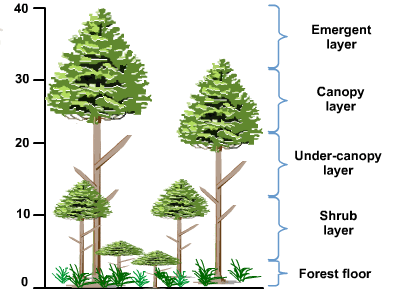Skip to main content
What is canopy
Canopy layer of forests
Dominant and co-dominant canopy trees form the uneven canopy layer. Canopy trees are able to photosynthesize relatively rapidly due to abundant light, so it supports the majority of primary productivity in forests.[citation needed] The canopy layer provides protection from strong winds and storms, while also intercepting sunlight and precipitation, leading to a relatively sparsely vegetated understory layer.
Forest canopies are home to unique flora and fauna not found in other layers of forests. The highest terrestrial biodiversity resides in the canopy of tropical rainforests.Many rainforest animals have evolved to live solely in the canopy, and never touch the ground.
The canopy of a rainforest is typically about 10m thick, and intercepts around 95% of sunlight. The canopy is below the emergent layer, a sparse layer of very tall trees, typically one or two per hectare. With an abundance of water and a near ideal temperature in rainforests, light and nutrients are two factors that limit tree growth from the understory to the canopy.
In the permaculture and forest gardening community, the canopy is the highest of seven layers.
Canopy (biology)
A canopy of a forest in Sabah, Malaysia
Canopy of a forest
Bamboo Canopy in the Western Ghats of India
In biology, the canopy is the aboveground portion of a plant community or crop, formed by the collection of individual plant crowns.
In forest ecology, canopy also refers to the upper layer or habitat zone, formed by mature tree crowns and including other biological organisms (epiphytes, lianas, arboreal animals, etc.).
Sometimes the term canopy is used to refer to the extent of the outer layer of leaves of an individual tree or group of trees.[citation needed] Shade trees normally have a dense canopy that blocks light from lower growing plants



Since as many as 70-90 percent of canopy tree species depend on animals for pollination and seed dispersal, numerous species are equipped with special mechanisms to ensure the proper species will take and deposit pollen in the proper plant species and disperse seeds in a suitable place. Plants pollinated by certain animals often have certain characteristics. For example, flowers pollinated by birds have brightly colored, cup-shaped flowers, while flowers pollinated by bats are often white nocturnal blooms with copious amounts of nectar. Flowers pollinated by flies often have a rotting or mildew-like smell just as "bee-flowers" have a sweet odor. Butterfly flowers have a mild odor and are red or orange, since butterflies are one of few insects with good color vision. These flowers are most common in light-gap and forest-edge plants species, so butterflies tend to be most abundant in these areas.
Due to the great diversity of flowering plant species in the rainforest, no one species dominates. Therefore it is sometimes difficult for a particular species, say bee species, to sustain itself feeding on the nectar of one species of tree. It may feed on the nectar of several species of tree within the same family. However, by doing this, there is a great risk of hybridization and much wasted pollen. Coevolution—the process where a trait in species A has evolved to a trait in species B, which had previously been affected by a trait in species A—has reduced this problem. The flower of one plant species (call it species A) has structures to deposit pollen on one particular part of the bee, maybe its left back leg. When the bee visits another species (call it species B), the pollen from species A will remain on the bee"s left back leg without being deposited in flower B. In the meantime, species B may plant its pollen on the upper part of the bee"s right wing. As the bee flies away from flower B, it will have pollen from both flower B and the previous flower it visited. When the bee lands in another flower A, the flower picks up the pollen off the beecs left hind leg because it is equipped with an apparatus to do so, and the flower is pollinated







Comments